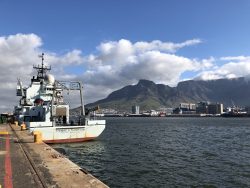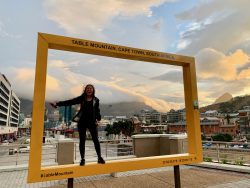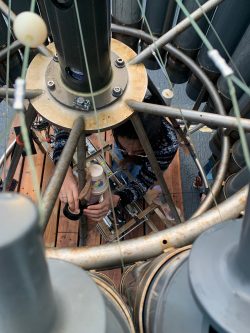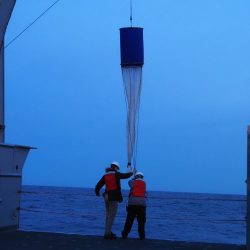
Being in the middle of the ocean on a giant research vessel can be surreal — in every direction, there’s water as far as the eye can see. For 17 seniors in the UW School of Oceanography, this was their reality for nearly two weeks as they conduct research for their thesis off the coast of South Africa.
“You’re so far from the coast, you forget the rest of the world is there,” says Ashley Lobao, an Oceanography student. “When we were coming back into port, and I started seeing land again, I thought ‘Oh wow…there’s something else I can go to that’s not just a ship on the water!’”
Seniors majoring in Oceanography are required to write a thesis in their final year. They pitch a formal proposal of their research in the fall, do the fieldwork during the winter, and then write up the results and present them to their peers and instructors in the spring. The experience is like a mini-grad school, where students get a taste of what research can be like.

This year’s group of seniors were in for a treat. The Thomas G. Thompson — UW’s world-class, ocean-going 274-foot-long research vessel — was docked in Cape Town, South Africa, waiting until the new year to take the students out to sea. The focus was to check out the 100 mile-wide Agulhas Rings, cores of warm water that spin off from the Agulhas Current traveling down the east coast of Africa into the Atlantic Ocean. Rings like these are common the world-over, and are important because they bring unique waters from one ocean into another. Scientists are interested in how these waters mix and what the implications might be.
“The simplest way to think about these rings is to imagine you have a cup of coffee, and you’re stirring it with your spoon. Then you pour in some milk, you see little tendrils come in. That happens in the ocean, with water masses at a massive scale,” says Lobao. “We care about these rings for all sorts of reasons: it has an impact on weather, it tells us how water moves and mixes, which, if you have an oil spill, helps us understand and predict with better accuracy where that oil might go, and how that mixing will impact the rest of the ocean.”

Lobao collected her measurements by using a CTD, which is a classic oceanography tool that measures seawater conductivity, temperature and depth, to understand the physical properties of the ring more clearly. Faculty and other senior scientists were onboard to help students collect data, offer guidance in the scientific questions they ask and troubleshoot challenges that arise when out at sea. Lobao is currently working on her results.
Lobao was struck at how life at sea was both intense while also being simple and straightforward. Students did their work in shifts, rotating around the clock because ship time is expensive and finite, keeping laser-focused on collecting data for their own projects and their classmates’. Weather and time of day didn’t matter — the research simply needed to get done. But between shifts there was downtime, especially because there was nowhere to go — no errands to run, no dinners at friend’s houses, no family around. So they strung a hammock at the ship’s bow, read a lot and watched movies.
The daily routine, though, was certainly punctuated by some moments of magic, the kind you only get when in the middle of the ocean. “There was one perfect day I remember. The water was so still and calm, and the sun had come out. And then, out of nowhere, there was a pod of whales,” says Lobao. What was initially one whale turned into six, and they were different species. “It was a really good day and the sunset was beautiful that night too.”

Back on land, the students are finishing their senior theses remotely, an unexpected end to their year brought on by COVID-19. Had the pandemic struck just slightly earlier, students may have lost the opportunity to go to sea on the R/V Thompson. Lobao can access the data she collected on the ship remotely and is able to continue with her thesis, yet she wishes she could instead meet with her instructors and the other students in person. Getting to know her fellow classmates during their time at sea, some of whom she shared classes with before but only knew their names, was one of the best parts of the whole experience. “I feel like this trip especially has brought us closer together, and I feel like we’re more of a graduating class now. We know each other.”
Professor of Oceanography Charlie Eriksen, chief scientist aboard the cruise, also acknowledged another benefit to their time at sea, especially as we continue to cope with coronavirus. “Ashley and her classmates met many unexpected challenges on this research cruise,” including illness, missed flights and a port closure due to bad weather. “Student education was not solely academic: coping with challenges of going to sea left students better prepared to deal with life during a pandemic than most landlubbers.”

